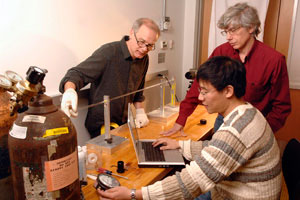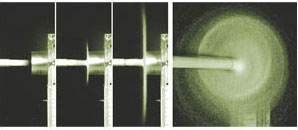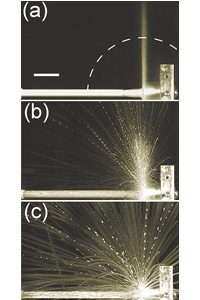Rapid collisions of packed particles produce liquid state in collider, tabletop experiments
By Steve Koppess-koppes@uchicago.edu
News Office
 Images courtesy of Xiang Cheng In work supported by the National Science Foundation and the W.M. Keck Foundation, University physicists Heinrich Jaeger (left), Professor in Physics, Xiang Cheng (seated), a graduate student in physics, and Sidney Nagel, the Stein Freiler Distinguished Service Professor in Physics, have produced through a tabletop experiment liquid-like behavior in a stream of granular materials. Scientists running experiments at Brookhaven National Laboratory also have observed liquid-like behavior in colliding subatomic particles that simulate conditions existing a fraction of a second after the big bang. | |
A paper published in 1883 reported how a stream of water hitting a narrow, flat, circular target becomes transformed into the thin, hollow shape of a bell. Would a stream of granular materials do likewise?
Xiang Cheng, a graduate student in Physics, performed an experiment to find out. He blasted streams of glass or copper beads through a tube and onto a flat target.
“The answer is: You can, in fact, see those bells,” said Heinrich Jaeger, Professor in Physics and the College. “Specifically, we find that the rapid collisions of densely packed particles produce the liquid state that we can then observe afterward, when everything flies apart and produces these beautiful envelope structures.”
Scientists using the Relativistic Heavy Ion Collider at Brookhaven National Laboratory have seen similar structures in experiments that simulate the birth of the universe. The $500 million collider smashes gold atoms into each other at nearly the speed of light. The tabletop Chicago experiment launches jets of granular materials into a flat target at no more than 12 miles an hour.
“There couldn’t be anything farther apart than our experiments and those at RHIC,” said Sidney Nagel, the Stein-Freiler Distinguished Service Professor in Physics and the College. Nevertheless, streams of granular particles bouncing off a target in the simple tabletop experiment at Chicago yielded a liquid-like behavior also witnessed at Brookhaven. “Nature plays the tricks that it knows how to play over and over again,” Nagel said.
Nagel and Jaeger’s research team published their findings last October in Physical Review Letters. Co-authors were Cheng, German Varas, a visiting graduate student from the University of Chile, and Daniel Citron, a Chicago third-year in Physics.
Scientists have attained a good understanding of equilibrium phenomena, which are governed primarily by temperature or pressure. But what about phenomena that have been pushed far beyond their equilibrium states, like a jet of sand? What about a quark-gluon plasma, the mixture of subatomic particles that existed for perhaps a few millionths of a second after the big bang?
 The first three images (side view), show a jet of glass beads at half a millisecond before and 2 1/2 and 9 1/2 milliseconds after colliding with a flat, cylindrical target. The image at far right (front view) shows the same liquid-like sheet of grains 35 1/2 milliseconds after impact. | |
 Decreasing the number of glass beads in a cross section of the jet changes the behavior of the granular stream after it hits a target—from a liquid-like pattern to one that looks like fireworks. This latter pattern is more characteristic of how individual particles would behave after hitting a wall. | |
“We really don’t know what the right concepts are to describe this,” Nagel said. “We love the physics of granular material because it allows us an entrée into this question in relatively simple experiments.”
In designing its tabletop experiment, the Chicago team addressed a fundamental question about equilibrium: Under what conditions does a collection of molecules, sand grains or other particles behave like a liquid? Macroscopic and subatomic particles sometimes behave in similar ways. The particles in the Chicago experiment are large enough to allow scientists to track them under precisely controlled conditions, an option not available on the subatomic scale.
The Chicago team conducted the experiment under a variety of conditions to ensure that interactions between the granular particles and the air did not affect the experimental results. “The key ingredient is the high density of rapid collisions,” Jaeger said.
The similarity between the granular-jet and RHIC experiments is surprising because scientists would expect quantum physics to dominate the results of the latter. Quantum physics typically rules the atomic and subatomic world. Classical physics, meanwhile, applies to much larger, everyday objects.
Nevertheless, the RHIC scientists have interpreted their results in a classical way. “They say it’s like a liquid. That’s a classical concept. Then they ascribe to this liquid such things as viscosity. Well, that’s a classical concept,” Nagel said. “Some of these phenomena that appear at this very microscopic, quantum scale echo phenomena that occur on the classical scale.
“That’s the amazing thing about physics. The laws you have at one level really are the same as at other levels, or at least influence what happens at other levels. Certain principles are just invariant. Conservation of energy and momentum—you can’t get away from these things on any scale.”
![[Chronicle]](/images/sidebar_header_oct06.gif)